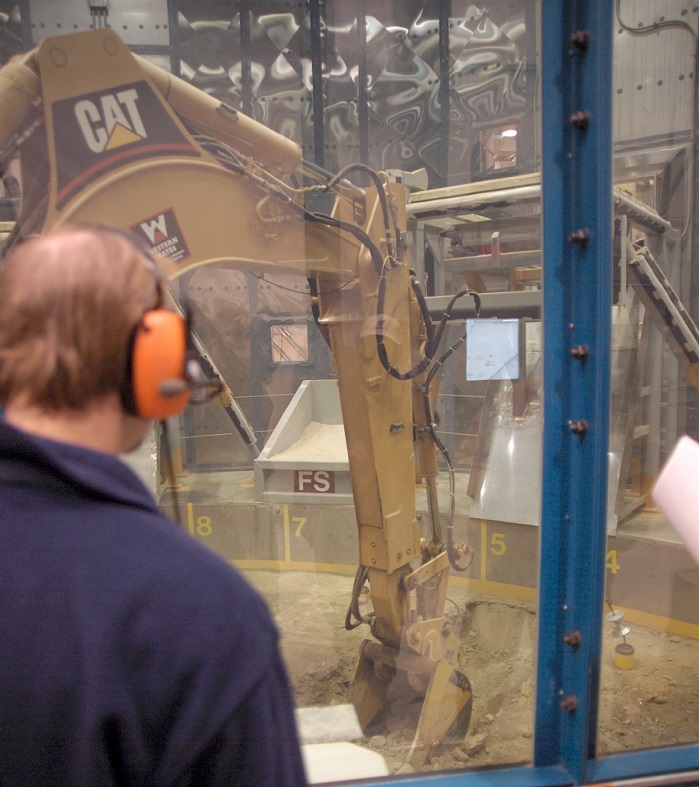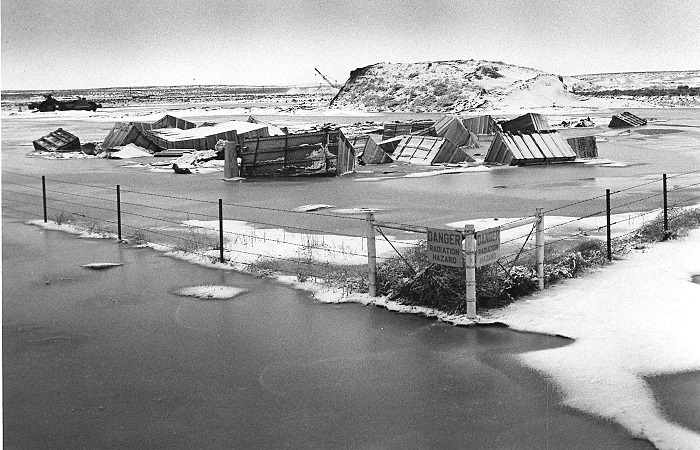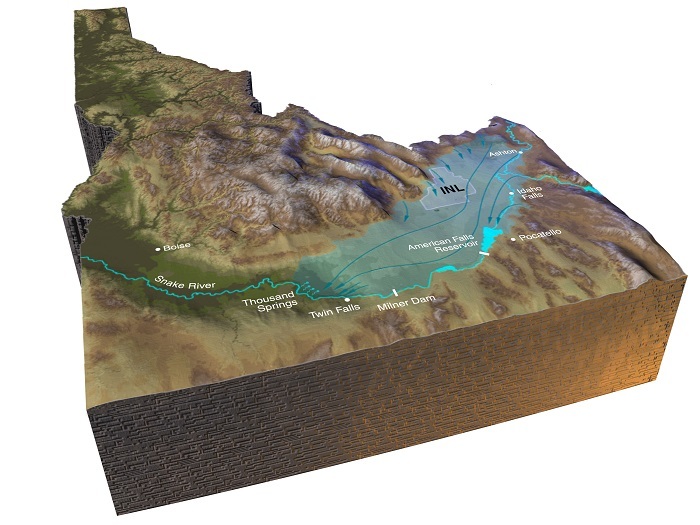 The glovebox excavator method project bred new life into the prospect that buried waste could be exhumed from Pit 9 and other pits within a 97-acre landfill known as the Subsurface Disposal Area at the DOE Idaho National Laboratory Site. The project also showed the potential to identify specific waste types, thereby allowing their targeted removal.
IDAHO FALLS, Idaho – In the early 1990s, DOE, the Environmental Protection Agency (EPA) and state of Idaho signed a record of decision to clean up a pit within a waste repository at the DOE Idaho National Laboratory Site using a chemical extraction process, which later proved unsuccessful.
The three government entities agreed to a new approach for Pit 9 that would fold the project into a broader buried waste environmental investigation at the landfill. In the meantime, they agreed to use the pit, which had last received waste in 1969, to obtain data on the condition of the buried waste containers and determine the feasibility of retrieving the waste.
A small building was erected over a portion of Pit 9 and a pie-shaped enclosure was built within the building to house and operate a remote-controlled excavator. Initially, probes were inserted into the waste zone that allowed engineers to insert detection equipment and cameras.
Later, the excavator dug up the equivalent of 900 drums of soil and waste material for analysis. At that point, a state of Idaho project manager noticed that the waste could be identified. Organic sludges could be identified by their rust or gray color. Graphite molds used in the manufacture of plutonium pits, and plutonium-contaminated filters also could be seen.
With this new data, the DOE, EPA and state agreed to use a process under the Comprehensive Environmental Response, Compensation and Liability Act to remediate a much larger portion of the 97-acre landfill, named the Subsurface Disposal Area. This new project would become the basis for all future remediation at the landfill.
-Contributor: Erik Simpson
 A view of a flooding event at the Idaho National Laboratory Site due to rapid snowmelt in 1969. A dike was later constructed around the Subsurface Disposal Area to channel water away from the 97-acre landfill.
IDAHO FALLS, Idaho – Environmental monitoring near a waste repository originally named the “burial ground” at the Idaho National Laboratory (INL) Site officially began in 1960 when the U.S. Geological Survey (USGS) began drilling wells at the landfill perimeter to monitor for the migration of radioactive and hazardous constituents.
Of primary interest was protection of the Snake River Plain Aquifer, the second-largest continuous aquifer in the U.S., flowing 585 feet below the landfill. The aquifer flows through layers of basalt rocks at a rate of several inches to several feet a day in a south-westerly direction. More than 300,000 Idahoans rely on the aquifer for farming, drinking water and municipal water supplies.
In 1970, former President Richard Nixon signed the National Environmental Policy Act due to public concerns of air and water pollution. Elected officials from Idaho began to focus on waste disposal practices at the INL Site landfill. Federal agencies and a governor-appointed task force evaluated the risks and stated that the buried waste wouldn’t present a threat to the aquifer. Nonetheless, the Atomic Energy Commission, a precursor agency to DOE, committed to remove the buried transuranic waste there by the end of the decade.
Two flooding events occurred at the burial ground, the second of which happened in 1969. Site photographers took photographs of floating barrels and boxes of waste. The flooding took place during a rapid warming trend that melted nearby snow, resulting in the water flowing toward the lowest part of the landfill.
Soon after, workers built a diversion berm around the landfill to prevent future flooding. They also constructed diversion dams to channel the flow of the Big Lost River away from the burial ground, which was later named the Subsurface Disposal Area.
 Early waste retrievals in the Subsurface Disposal Area at the Idaho National Laboratory Site showed the extent of waste drum and box decay.
In 1971, engineers conducted tests to determine the condition of the waste and containers in the landfill and the soil migration of plutonium contaminants. They also assessed the ability to control the spread of contamination during waste retrieval, and the estimated costs for retrieval operations.
Later in the 1970s, workers removed more than 20,000 drums from portions of the landfill. They repackaged their contents in new drums and moved the drums to a nearby asphalt pad for above-ground disposal.
Crews continued to exhume buried waste in 1976, unearthing nearly 820 drums from the landfill. A few years later, engineers noted that drums and wooden boxes in the landfill had deteriorated to a point that workers could not retrieve additional containers.
By that time, the USGS was documenting the presence of trace amounts of radionuclides and higher concentrations of hazardous waste in wells adjacent to the burial ground. This prompted additional concerns by Idaho’s elected officials.
-Contributor: Erik Simpson
 Concern over impacts to the Snake River Plain Aquifer from past waste disposal practices drove the cleanup actions at the Subsurface Disposal Area at the DOE Idaho National Laboratory Site.
IDAHO FALLS, Idaho – Following several buried waste exhumation projects in the 1970s, the DOE Idaho National Laboratory (INL) Site tested technologies to allow for a larger waste retrieval effort and attempt to minimize the spread of contaminated soil.
In the late 1980s, engineers were developing a plan to demonstrate the use of vitrification for specific buried waste pits. Using high-electricity probes throughout a pit could conceivably melt the waste and surrounding soil together into a mass. Later, they tested various plastic resins to inject into a simulated waste pit using a high-pressure drill rig. Once hardened, the mass could be broken into manageable and retrievable pieces.
Also during that time, remediation contractors, working with INL Site engineers, proposed a demonstration project at one of the landfill pits using their proprietary retrieval and treatment processes. Pit 9 was selected because it was one of the last buried waste pits, in use until 1969.
In the 1990s, engineers experimented with cryogenics — a science that addresses the production and effects of low temperatures. A simulated waste pit, complete with empty barrels and boxes, was created within a portable tent. Liquid nitrogen was injected into the simulated waste pit to freeze the contents and surrounding soil. Heavy equipment was used to break up the mass.
Although these retrieval technologies showed some promise, they were abandoned due to technical challenges. Later however, certain sections of the landfill, called the Subsurface Disposal Area, were injected with paraffin wax to encapsulate specific waste types, preventing the release of contaminants into the surrounding soil.
In 1989, cleanup of the buried waste took a different turn after the INL Site was added to the Environmental Protection Agency’s (EPA) National Priorities List of Superfund Sites due to suspected and confirmed releases of radioactive and hazardous waste into the underlying Snake River Plain Aquifer.
Now a Superfund site, the INL Site entered into a tri-party agreement between the DOE, state of Idaho and EPA. In the next two years, the agencies compiled a list of suspected and confirmed waste release sites, assigned the sites the Superfund designation of waste area group (WAG) or operable unit (OU), and developed a schedule for investigation and cleanup if necessary.
In 1991, the agencies signed the Federal Facility Agreement and Consent Order and associated action plan. The buried waste site received its own waste area group — WAG 7 — and operable unit — OU 7-13/-14 — designations.
-Contributor: Erik Simpson
 Crews at left perform stacked waste disposal at the Subsurface Disposal Area at the Idaho National Laboratory Site in the 1950s. At right, workers use a lifting tractor trailer to dispose of waste at the landfill in the 1960s.
IDAHO FALLS, Idaho – Just months after the Experimental Breeder Reactor-I began generating electricity in December 1951 in a historic first, the Idaho National Laboratory (INL) Site opened its first waste repository on the 890-square-mile Atomic Energy Commission (AEC) site.
Originally named the “burial ground,” the 13-acre landfill in the south-central portion of the INL Site was constructed to receive radioactive and hazardous waste generated from the reactor and other facilities onsite. The location was chosen because it didn’t have alternating layers of volcanic basalt and soil like most areas of the Arco Desert. Instead, it had more than 25 feet of relatively uninterrupted soil.
Beginning in 1954, the burial ground, later renamed the Subsurface Disposal Area, was expanded to 88 acres and began accepting waste from commercial entities and other AEC sites, primarily the former Rocky Flats Plant near Denver, Colorado. The AEC was a precursor agency to DOE.
Landfill crews used heavy equipment to dig down 25 feet to a basalt layer, backfilled a few feet, and then began hand-stacking barrels and boxes of waste on the clean soil. Due to concerns of personnel exposure, waste eventually was dumped into pits using lifting tractor trailers.
The waste disposed in the landfill that originated from Rocky Flats included graphite molds contaminated with plutonium, air filters, solidified sludges containing radioactive and hazardous constituents, and pyrophoric uranium fines. The landfill also accepted radiological medical waste from throughout the complex, beryllium reflector blocks from an onsite reactor, highly radioactive metal debris, pyrophoric sodium potassium waste, and even common industrial waste such as a pickup truck bed.
For the pits, the disposal process was the same. After several feet of waste was disposed, heavy equipment placed clean soil over the waste and compacted it by driving over the top of it. In an exception to that process, workers constructed an asphalt pad to place containers of nitrate salts. When full, it was covered with clean soil.
In all, approximately 241,000 cubic meters of waste were disposed in 21 pits, 58 trenches and 21 soil vault rows.
In 1970, the AEC changed its policy for the disposal of transuranic waste, opting for above-ground disposal in lieu of burial. Crews constructed a 7-acre asphalt pad southeast of the landfill and began stacking barrels and boxes of waste for the next two decades.
-Contributor: Erik Simpson
|